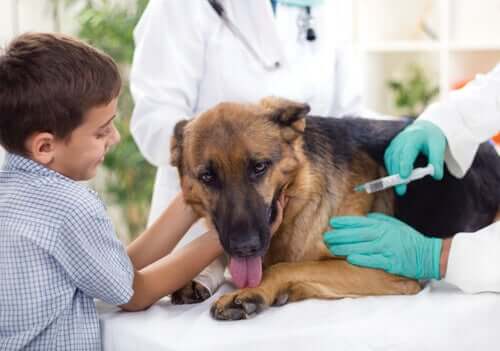Tips on Taking Your Dog to the Pool


Written and verified by the lawyer Francisco María García
If your dog loves the water and you’d like to be able to swim with it, you don’t need to wait for summer vacation anymore! You won’t even need to go to the beach. With the right care and preparation, you can start taking your dog to the pool with you. It’s your new summer go-to!
Like humans, animals can get sick in ways that don’t just involve their body. Many can actually experience depression and related symptoms. Food, water, and walks are important, but so are happiness and free expression if you want your dog to be healthy.
Taking your dog swimming at the pool is a great option in that sense. It gives it a chance to exercise, and you can both have some fun together in the water.
Tips on taking your dog to the pool
Keeping vaccinations and de-worming treatments up-to-date
It’s crucial to take preventative measures for your dog’s health. That’s true whether you’re taking it to the pool or not. It just becomes even more necessary when you’re bringing it somewhere it’s going to be in the water with other people and/or animals.

Your dog needs to be up-to-date on all of its shots. It’s also crucial, though, to make sure you do some kind of de-worming treatment a few weeks before taking your dog to the pool.
Adaptation periods
Your dog isn’t going to get used to the pool overnight. If it’s the first time you’ve taken it to one, then you need to be patient and give it time to adapt.
Firstly, never force your dog to get into the pool. Every dog has its own adaptation periods, and readiness to get in. Start by getting it curious, giving it rewards for playing in or with the water, putting its favorite toy in the water, etc…
Make the pool seem like something fun, and a safe place for your dog to experiment.
A good level of chlorine
Animals don’t have the same level of tolerance to chlorine as humans do. It’s extremely important to check on the chlorine level in the pool before your dog gets in. You also need to make sure dogs are allowed in the pool, of course.
At proper levels, chlorine is a key part of keeping the still water in a pool safe for swimming. It can kill up to 99% of all the fungus, bacteria, and parasites in the water.
But, too much chlorine or other chemical substances can do some serious damage to your dog’s health. It could cause minor things like irritation, or potentially fatal things like poisoning.
Don’t leave it alone
Your dog might get cramps in its legs, or its legs might fall asleep. This is just part of why it’s important not to leave it alone in the pool. Some trainers recommend using a leash when you’re taking your dog into the pool. That will make it easier for you to keep track of it and take it out if you need to.
Pools for dogs
Some theme parks and spas have pools made so that dogs can swim in them. There are also lots of businesses nowadays with pools just for this. If you have a pool at home, you’ll need to install at least one stairway for it to get in and out on its own.
Sun care and protection
Overexposure to the sun and its ultraviolet rays can be very harmful to both dogs and humans. Luckily, there are already some protective products for dogs out there. Outside of that, you need to make sure to keep your dog hydrated on sunny days. Lots of shade and water are the best way to keep your furry friend happy and healthy.
Don’t feed it while it’s swimming
It’s best not to feed your dog while it’s swimming in the pool, or as it’s about to. This could cause digestive problems and potentially lead to vomiting.
You should ideally feed it a few hours before and after taking it to the pool.
Be careful of getting water in its ears

Heat and moisture make for a ripe breeding ground for fungi and bacteria in your dog’s ears. That makes it vital for you to dry off its ears well with some kind of cotton cloth.
Freshwater baths to get the chlorine off
You should also bathe your dog with fresh water after you’ve taken it into the pool to get the chlorine off. This is actually a good tip for both dogs and humans.
After you’ve bathed it, make sure you dry it off well. Use a clean, dry towel to make sure you don’t leave any skin or fur damp. Otherwise, your dog’s fur could start to smell bad, and it could allow fungi to grow on its skin.
You need to follow these tips before, during, and after you take your dog to the pool. That’s the best way to enjoy the summer and the water responsibly alongside your dog.
If your dog loves the water and you’d like to be able to swim with it, you don’t need to wait for summer vacation anymore! You won’t even need to go to the beach. With the right care and preparation, you can start taking your dog to the pool with you. It’s your new summer go-to!
Like humans, animals can get sick in ways that don’t just involve their body. Many can actually experience depression and related symptoms. Food, water, and walks are important, but so are happiness and free expression if you want your dog to be healthy.
Taking your dog swimming at the pool is a great option in that sense. It gives it a chance to exercise, and you can both have some fun together in the water.
Tips on taking your dog to the pool
Keeping vaccinations and de-worming treatments up-to-date
It’s crucial to take preventative measures for your dog’s health. That’s true whether you’re taking it to the pool or not. It just becomes even more necessary when you’re bringing it somewhere it’s going to be in the water with other people and/or animals.

Your dog needs to be up-to-date on all of its shots. It’s also crucial, though, to make sure you do some kind of de-worming treatment a few weeks before taking your dog to the pool.
Adaptation periods
Your dog isn’t going to get used to the pool overnight. If it’s the first time you’ve taken it to one, then you need to be patient and give it time to adapt.
Firstly, never force your dog to get into the pool. Every dog has its own adaptation periods, and readiness to get in. Start by getting it curious, giving it rewards for playing in or with the water, putting its favorite toy in the water, etc…
Make the pool seem like something fun, and a safe place for your dog to experiment.
A good level of chlorine
Animals don’t have the same level of tolerance to chlorine as humans do. It’s extremely important to check on the chlorine level in the pool before your dog gets in. You also need to make sure dogs are allowed in the pool, of course.
At proper levels, chlorine is a key part of keeping the still water in a pool safe for swimming. It can kill up to 99% of all the fungus, bacteria, and parasites in the water.
But, too much chlorine or other chemical substances can do some serious damage to your dog’s health. It could cause minor things like irritation, or potentially fatal things like poisoning.
Don’t leave it alone
Your dog might get cramps in its legs, or its legs might fall asleep. This is just part of why it’s important not to leave it alone in the pool. Some trainers recommend using a leash when you’re taking your dog into the pool. That will make it easier for you to keep track of it and take it out if you need to.
Pools for dogs
Some theme parks and spas have pools made so that dogs can swim in them. There are also lots of businesses nowadays with pools just for this. If you have a pool at home, you’ll need to install at least one stairway for it to get in and out on its own.
Sun care and protection
Overexposure to the sun and its ultraviolet rays can be very harmful to both dogs and humans. Luckily, there are already some protective products for dogs out there. Outside of that, you need to make sure to keep your dog hydrated on sunny days. Lots of shade and water are the best way to keep your furry friend happy and healthy.
Don’t feed it while it’s swimming
It’s best not to feed your dog while it’s swimming in the pool, or as it’s about to. This could cause digestive problems and potentially lead to vomiting.
You should ideally feed it a few hours before and after taking it to the pool.
Be careful of getting water in its ears

Heat and moisture make for a ripe breeding ground for fungi and bacteria in your dog’s ears. That makes it vital for you to dry off its ears well with some kind of cotton cloth.
Freshwater baths to get the chlorine off
You should also bathe your dog with fresh water after you’ve taken it into the pool to get the chlorine off. This is actually a good tip for both dogs and humans.
After you’ve bathed it, make sure you dry it off well. Use a clean, dry towel to make sure you don’t leave any skin or fur damp. Otherwise, your dog’s fur could start to smell bad, and it could allow fungi to grow on its skin.
You need to follow these tips before, during, and after you take your dog to the pool. That’s the best way to enjoy the summer and the water responsibly alongside your dog.
This text is provided for informational purposes only and does not replace consultation with a professional. If in doubt, consult your specialist.








